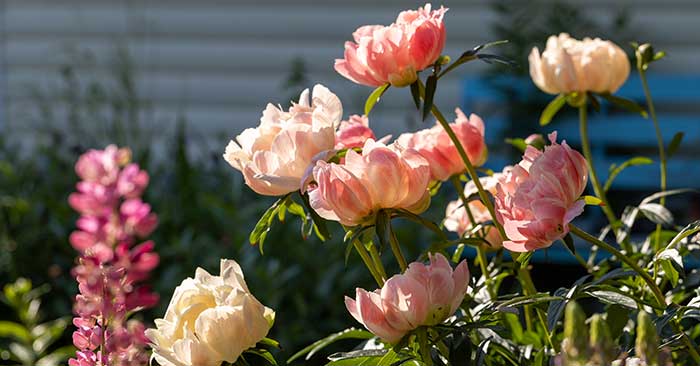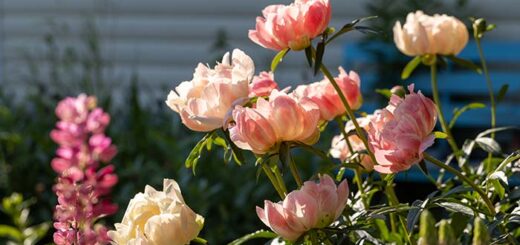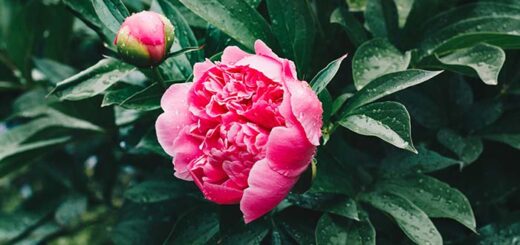Cutting Back Peonies in Fall: A Guide to Healthier Plants
Peonies, with their vibrant blooms, are a popular choice among gardeners. As the summer ends and the chill of fall sets in, it’s time to start thinking about cutting back your peony plants. This is a crucial task as it helps the plants prepare for the winter dormancy period and promotes healthier growth in the following spring. But how can you do it correctly to ensure your plants remain healthy and robust?
By the end, you’ll be well-equipped to confidently tackle this essential gardening task, ensuring your peonies thrive year after year, rewarding you with their stunning blooms.
Why Should You Cut Back Peonies in the Fall?
Health Benefits for the Plant
Trimming peonies in autumn is crucial for maintaining the overall health of your plants. Removing the foliage prevents the spread of fungal diseases that can thrive on decaying leaves. When the leaves and stems are left to wither and rot, they create a perfect breeding ground for harmful pathogens.
These diseases can overwinter and infect new growth in the spring, leading to stunted growth and poor blooming. Properly cutting back ensures that your peonies remain disease-free and vigorous.

Image Source: Envato Elements
Prevention of Diseases and Pests
Peony plants are susceptible to various diseases, such as botrytis blight, which can cause significant damage. Removing the spent foliage eliminates the habitat for pests and fungal spores. This simple practice reduces the risk of infestations and infections, ensuring your peonies grow strong and healthy.
Additionally, trimming in the fall helps to remove any lingering insect eggs or larvae that might harm your plants in the coming seasons.
Must Read Article: Care for Peonies after they Bloom
When is the Best Time to Cut Back Peonies?
Ideal Timing in the Fall Season
The optimal time for pruning peonies is after the season’s first frost. The frost will have caused the leaves to turn yellow and die back, signaling that the plant is ready to enter its dormant phase.
The plant has stored enough energy in its roots for the next growing season, making it safe to remove the above-ground growth. Waiting for the first frost ensures the plant has completed its natural development and energy storage cycle.
Signs That Indicate It’s Time to Trim
Several signs can help you determine when it’s the right time to trim your peonies. First, look for yellowing or browning leaves, which indicate that the plant is no longer photosynthesizing effectively.
Additionally, the stems will become dry and brittle. These are natural indications that the plant is ready to be pruned. If you observe mold or mildew on the foliage, it’s a clear sign that it’s time to clean up the plant to prevent the spread of disease.
How to Properly Cut Back Peonies
Tools You’ll Need
Before you begin, gather the necessary tools. You will need a pair of sharp pruning shears, gardening gloves, and a clean cloth or disinfectant. Using clean and sharp tools to make precise cuts and minimize the risk of introducing diseases to the plant is essential. Disinfect your pruning shears with alcohol or a bleach solution before and after use to ensure they are pathogens-free.
Step-by-Step Guide to Cutting Back Peonies
- Prepare Your Area: Clear the area around your peonies so you can easily access the base of the plant. Remove any debris or fallen leaves from previous seasons.
- Cut the Stems: Using your pruning shears, cut each stem to about 1-2 inches above the soil level. Make clean cuts to avoid damaging the root system. Remove all the foliage and stems, as leaving any behind can harbor diseases.
- Inspect the Base: After cutting back, inspect the plant’s base for signs of disease or pests. Remove any diseased parts and dispose of them properly.
- Clean Up: Collect all the cuttings and remove them from your garden. Do not compost them, as they may contain disease spores or pests. Instead, dispose of them in your green waste bin or burn them if local regulations allow.
- Mulch the Soil: Applying a layer of mulch around the base of the plant can help protect the roots during the winter. It will also help retain moisture and suppress weeds.
Post-Cutting Care
After you’ve finished pruning, it’s essential to take a few additional steps to ensure your peonies are well-prepared for winter:
- Dispose of the cuttings properly to prevent any disease from spreading. Do not add them to your compost pile; use a green waste bin or burn them if possible.
- Consider adding a layer of mulch around the base of the plant. This will help insulate the roots against cold temperatures and retain moisture in the soil.
- Give the area a thorough clean-up to remove any remaining debris.
Must Read Article: Why are your Peonies not Blooming
Common Mistakes to Avoid
Avoid cutting back your peonies too early, as this can interfere with the plant’s ability to store energy for the next season. Similarly, cutting back too late can expose the plant to frost damage.
Always ensure your tools are clean and sharp to prevent the introduction of diseases. Lastly, remember not to leave cuttings on the ground, as they can harbor pests and diseases.
Post-Cutting Care
How to Dispose of Cuttings
Once you have pruned your peonies, it is crucial to handle the cuttings appropriately to prevent any potential disease spread. After trimming, gather all the cut stems and leaves and place them in a green waste bin or burn them if local regulations permit. Do not compost these cuttings, as they may carry disease spores or pests that can infect your compost and subsequently spread to other parts of your garden. Proper disposal is essential for maintaining a healthy garden environment.
Preparing the Soil for Winter
After you have pruned the foliage, it is beneficial to prepare the soil to protect your peonies during the colder months. One effective method is to apply a layer of organic mulch around the base of the plants. This mulch can consist of shredded bark, straw, or compost. Mulching helps to insulate the roots from extreme cold temperatures, retain soil moisture, and suppress weeds. Additionally, consider adding a slow-release fertilizer to provide essential nutrients that will support the roots over the winter and give the plants a strong start in the spring.
Winter Protection Techniques
If you live in an area with particularly harsh winters, additional protective measures may be necessary. For instance, after mulching, you can cover the base of your peonies with a burlap sack or frost cloth. This provides extra insulation and protection from freezing winds. Be sure to secure the covering so it doesn’t blow away. Monitoring the weather and adding extra protection as needed can make a significant difference in the health of your peonies when they emerge in the spring.
Common Mistakes to Avoid
Cutting Back Too Early or Too Late
Timing is critical when it comes to pruning your peonies. One common mistake is to trim them back too early in the season, before the first frost. Doing so can deprive the plants of the time they need to store energy in their roots for the next growing season. On the other hand, cutting back too late, especially after multiple frosts, can expose the plants to damage and increase the risk of disease. Aim to trim after the first frost when the foliage has naturally begun to die back.
Not Cleaning Tools Properly
Another frequent error is using dirty or dull tools for pruning. Dirty tools can harbor pathogens that may infect your peonies, while dull tools can cause jagged cuts that are harder for the plant to heal. Always clean your pruning shears with alcohol or a bleach solution before and after each use. Sharpen your tools regularly to ensure clean, precise cuts. Investing in good quality tools and maintaining them properly can significantly reduce the risk of spreading diseases.
Ignoring Soil and Root Care
After you have pruned your peonies, it’s essential to give attention to the soil and roots. Neglecting this aspect can undermine the benefits of proper pruning. Applying mulch and fertilizer, as mentioned earlier, is critical for root health and soil fertility. Failing to do so can lead to poor growth and reduced flowering in the next season. Additionally, ensure that the soil remains well-drained to prevent root rot, especially during wet winter months.
FAQs About Cutting Back Peonies
Answering Common Questions from Gardeners
- When exactly should I trim my peonies?
- The best time to prune peonies is after the first frost of the fall season. This usually occurs when the foliage begins to yellow and die back naturally.
- What should I do if my peonies have mold on the leaves?
- If you notice mold or mildew on the leaves, it’s a clear sign to prune them immediately. Cut back all affected foliage and dispose of it properly to prevent the spread of disease.
- Can I use the cuttings as mulch?
- No, do not use the cuttings as mulch. They can harbor diseases and pests. It’s best to dispose of them in a green waste bin or burn them if permitted.
- Should I water my peonies after pruning them?
- Yes, give your peonies a deep watering after pruning to help the roots settle. However, avoid overwatering as peonies prefer well-drained soil.
- Is it necessary to fertilize peonies in the fall?
- While not absolutely necessary, applying a slow-release fertilizer can be beneficial. It provides essential nutrients that support root health and help the plant prepare for the next growing season.
Additional Tips for a Healthy Peony Plant
- Monitor for Pests: Even after pruning, keep an eye out for any signs of pests around your peonies. Early detection and treatment can prevent significant damage.
- Check Soil pH: Peonies prefer slightly acidic to neutral soil (pH 6.5-7). Testing your soil and amending it if necessary can promote better growth.
- Rotate Mulch Annually: Change your mulch each year to prevent the build-up of diseases and pests. Fresh mulch helps to keep the soil healthy and free of contaminants.


